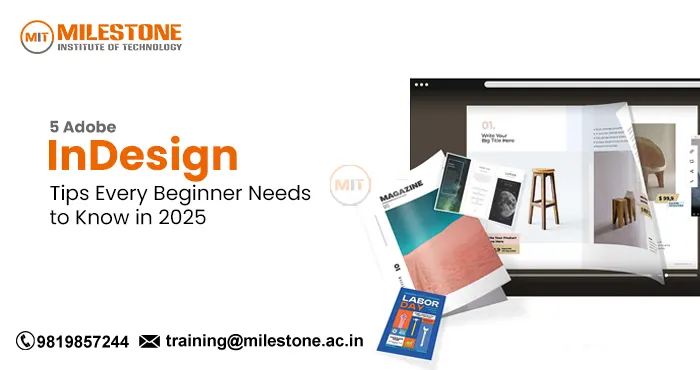
Introduction
When you’re first learning Adobe InDesign, it can feel insanely overwhelming. This powerful desktop publishing application is used by professionals working on anything from marketing and business cards to newspapers and magazines. Whether you’re building brochures, flyers, reports, magazines or any other kind of document, nothing says professional quite like Adobe InDesign, the linchpin of all sorts of professions in modern design. Today we have these 5 Adobe InDesign tips beginners should know in 2025. These are Adobe InDesign tips that not only make you work faster but also improve your design quality.Why Learn Adobe InDesign?
Before we look at these 5 Adobe InDesign tips, let’s take a look at why Adobe InDesign is still the industry standard in 2025. It is unrivaled for mastering typography, whether it be on the single page, or multiple pages, of a multipage document. And, of course, it’s fully integrated with other Adobe Creative Cloud apps like Photoshop and Illustrator.
If you are interested in creating print-ready or digital publications, you’ll definitely benefit from these Adobe InDesign tips. One of the most helpful Adobe InDesign tips for beginners is the use of master pages. Master Pages are like document templates, in that you can easily create consistent headers, footers, page numbers, or even a new logo that will be repeated on various pages.
Rather than placing repeated elements on every page, you can place them once on a master page and it will be reflected every page.How to Use Master Pages:
- Open the Pages panel (Window > Pages).
- Double-click on the A-Master page to open to edit.
- Include elements such as page numbers or logos.
- Drag the master to any page by dropping it on the page thumbnail.
Master Text Styles for Efficient Typography Management
One of the many strong points is the use of typography. For attractive layouts you need to keep your fonts, sizes, colors, and spacing consistent. The trick here is knowing Paragraph and Character Styles. Creating text styles not only helps to work faster but also allows for easy global changes. For instance, if you decide you prefer all your headings to be red instead of blue, change the paragraph style, and the entire document instantly changes to match.How to Create Text Styles:
- Select the text you would like to be stylized.
- Navigate to Window > Styles > Paragraph or Character Styles.
- Click on the new style button, and set the font, size, color etc.
- Apply the style to similar text throughout your document.
Leverage Grids and Guides for Perfect Alignment
Proper alignment and spacing are essential for the clean professional look. This is something beginners often overlook, resulting in uneven text and picture placement. InDesign grids and guides allow you to snap objects to a grid, keeping order and balance in the overall structure of your project.Tips for Using Grids and Guides:
- Enable the baseline grid (View > Grids & Guides > Show Baseline Grid).
- Use margins and column guides when setting up your document.
- Drag guides from the rulers (View > Show Rulers) to position objects precisely.
- Use “Snap to Guides” (View > Grids & Guides > Snap to Guides) for easier alignment.
Import and Link Images Correctly
In many layout scenarios, images are an important part, and knowing how to import and handle them is crucial. By linking images instead of embedding files, InDesign keeps your file size down and lets you quickly update an image.Best Practices for Working with Images:
- Use File > Place to insert images instead of copying and pasting.
- Keep your image files organized in folders to avoid broken links.
- Update links via the Links panel if the original files change.
- Use fitting options (Object > Fitting) to ensure images scale properly within frames.
Export for Print and Digital with the Right Settings
It’s really important to understand how to export your final document, especially if you plan to print professionally or publish it online! Adobe InDesign provides a host of export options, for every occasion, from high-resolution PDFs for print to interactive PDFs or ePub for digital platforms.Export Tips for Beginners:
- Print: Export as PDF (Print) with high settings. Make sure fonts are embed and crop marks are included if necessary.
- For digital: Submit your text in PDF (Interactive) or ePub format to maintain hyperlinks and interactivity.
- If your design has any elements that bleed to the edge, check the “Bleed and Slug” settings at the time of exporting.
- Ensure to always preview the export before you save it to detect any layout or color issues.
Bonus Tip: Explore Adobe InDesign tips and shortcuts
Learning keyboard shortcuts will help you speed up your workflow. Here are some handy shortcuts to get started with if you are a beginner:- Ctrl + D (Cmd + D on Mac): Place an image or file.
- Ctrl + Shift + E: Export document.
- Ctrl + G: Save selected items to a new group.
- Ctrl + Shift + P: Enable or disable the Pages panel.
Conclusion:
Adobe InDesign is a major publishing software for anyone who cares about graphic design. These Adobe InDesign tips are a great place for beginners to build a solid foundation and a clear understanding of how to create professional layouts with confidence in 2025.
Never forget to use Master Pages to keep it in check, take advantage of text styles to help you with the typography, align your design through grids and guides, manage your images properly and also export with the right settings related to your project. It takes practice and a little patience, and with the right tips, you’ll be an InDesign pro.


